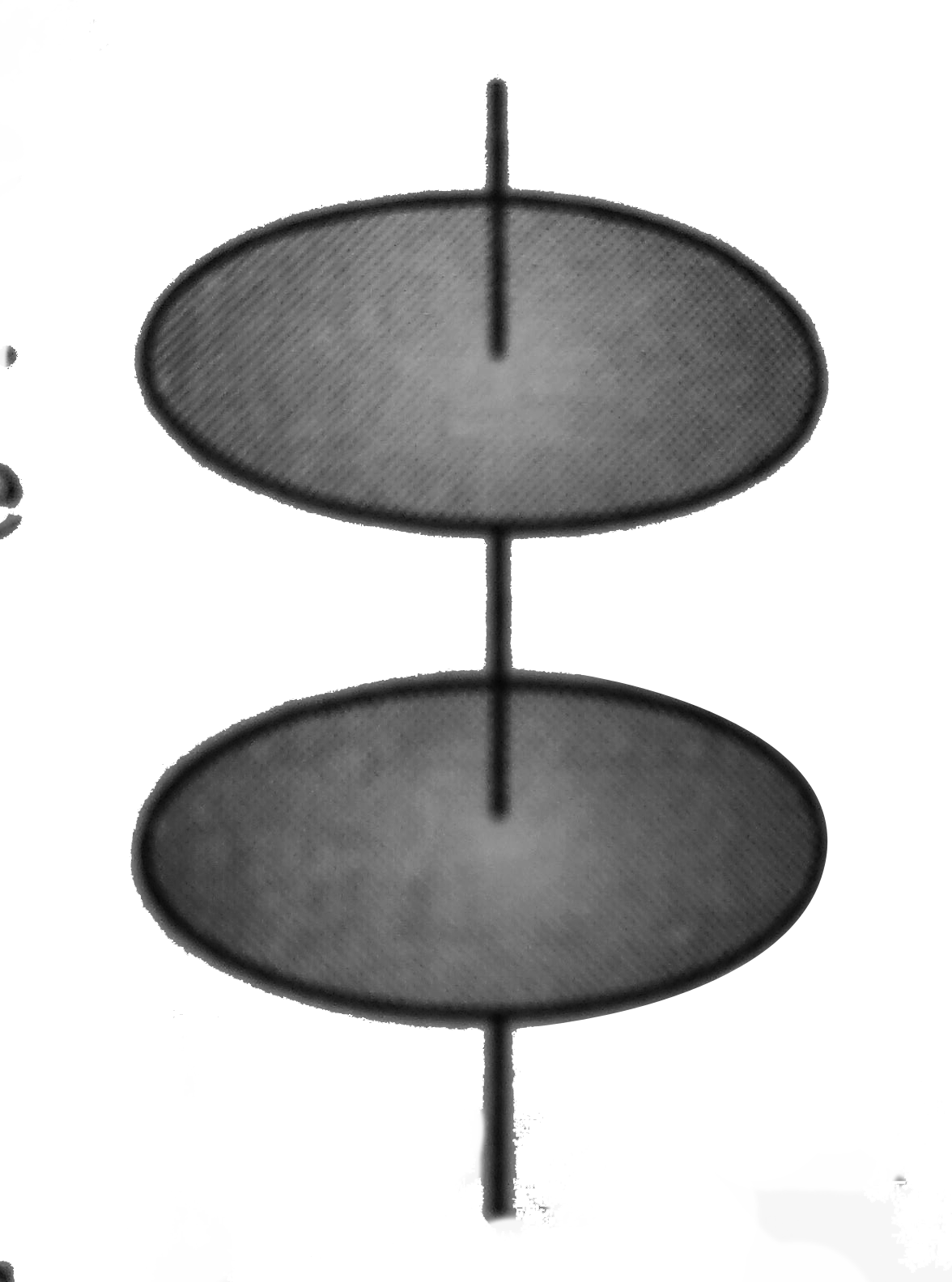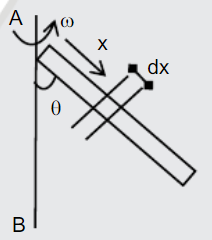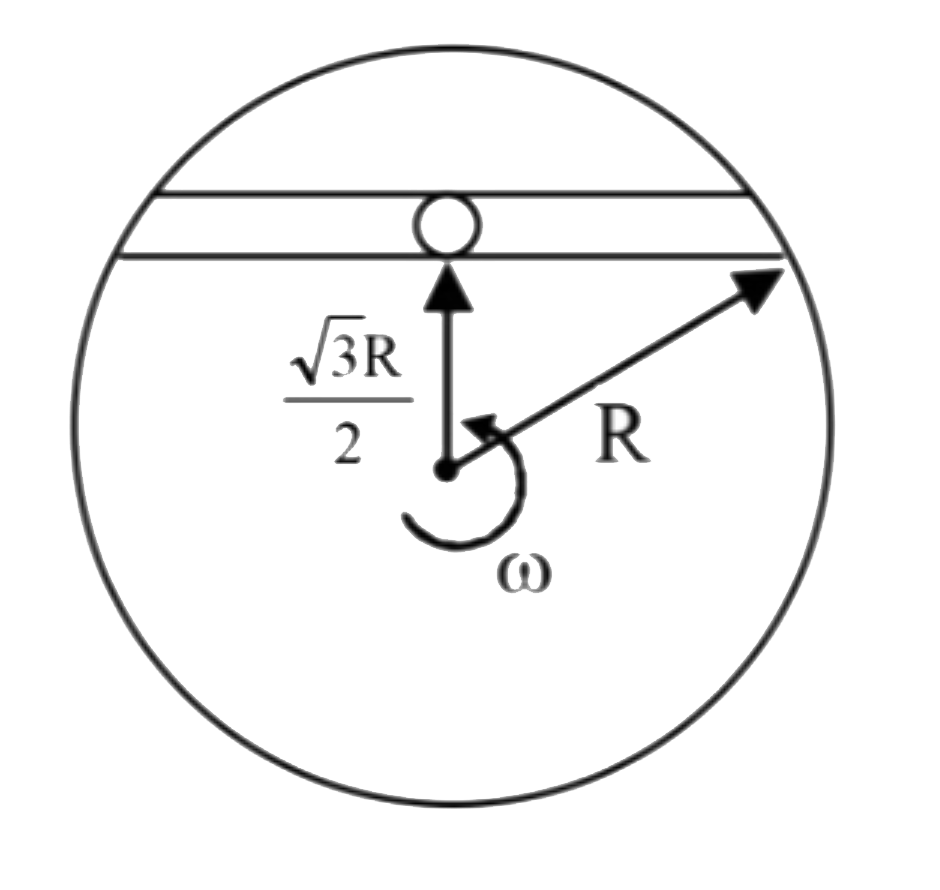Disk 1 rotates about a smooth vertical axis with the angular velocity ω1. Disk 2 rotating with the angular velocity ω2 is kept on disk 1 while rotating in the same direction. Find the change in the rotational kinetic energy of the system given that the moments of inertia of the disks relative to the rotation axis are equal to I1andI2, respectively. The constant surface of the disks are rough.
To find the change in the rotational kinetic energy of the system consisting of two disks, we will follow these steps:
Step 1: Understand the Initial Conditions
We have two disks:
- Disk 1 with moment of inertia I1 and angular velocity ω1.
- Disk 2 with moment of inertia I2 and angular velocity ω2.
The disks are rotating in the same direction, but with different angular velocities.
Step 2: Calculate Initial Rotational Kinetic Energy
The initial rotational kinetic energy (KE) of the system can be calculated as:
KEinitial=12I1ω21+12I2ω22
Step 3: Apply Conservation of Angular Momentum
When the two disks come into contact, they will eventually rotate together at a common angular velocity ω. By the conservation of angular momentum:
I1ω1+I2ω2=(I1+I2)ω
From this, we can solve for ω:
ω=I1ω1+I2ω2I1+I2
Step 4: Calculate Final Rotational Kinetic Energy
The final rotational kinetic energy of the system when both disks rotate together at angular velocity ω is:
KEfinal=12(I1+I2)ω2
Substituting the expression for ω:
KEfinal=12(I1+I2)(I1ω1+I2ω2I1+I2)2
This simplifies to:
KEfinal=(I1ω1+I2ω2)22(I1+I2)
Step 5: Calculate Change in Rotational Kinetic Energy
The change in rotational kinetic energy is given by:
ΔKE=KEfinal−KEinitial
Substituting the expressions we derived:
ΔKE=(I1ω1+I2ω2)22(I1+I2)−(12I1ω21+12I2ω22)
Step 6: Simplify the Expression
After simplifying the above expression, we can factor out common terms and arrive at the final expression for the change in rotational kinetic energy:
ΔKE=−I1I22(I1+I2)(ω1−ω2)2
Final Answer
The change in the rotational kinetic energy of the system is:
ΔKE=−I1I22(I1+I2)(ω1−ω2)2
We have two disks:
- Disk 1 with moment of inertia I1 and angular velocity ω1.
- Disk 2 with moment of inertia I2 and angular velocity ω2.
The initial rotational kinetic energy (KE) of the system can be calculated as:
KEinitial=12I1ω21+12I2ω22
When the two disks come into contact, they will eventually rotate together at a common angular velocity ω. By the conservation of angular momentum:
I1ω1+I2ω2=(I1+I2)ω
From this, we can solve for ω:
ω=I1ω1+I2ω2I1+I2
The final rotational kinetic energy of the system when both disks rotate together at angular velocity ω is:
KEfinal=12(I1+I2)ω2
Substituting the expression for ω:
KEfinal=12(I1+I2)(I1ω1+I2ω2I1+I2)2
This simplifies to:
KEfinal=(I1ω1+I2ω2)22(I1+I2)
The change in rotational kinetic energy is given by:
ΔKE=KEfinal−KEinitial
Substituting the expressions we derived:
ΔKE=(I1ω1+I2ω2)22(I1+I2)−(12I1ω21+12I2ω22)
After simplifying the above expression, we can factor out common terms and arrive at the final expression for the change in rotational kinetic energy:
ΔKE=−I1I22(I1+I2)(ω1−ω2)2
The change in the rotational kinetic energy of the system is:
ΔKE=−I1I22(I1+I2)(ω1−ω2)2
Topper's Solved these Questions
- RIGID BODY DYNAMICS - IBOOK - RESNICK AND HALLIDAYCHAPTER - RIGID BODY DYNAMICS - IEXERCISE - CHECKPOINT
18 Videos
- RIGID BODY DYNAMICS - IBOOK - RESNICK AND HALLIDAYCHAPTER - RIGID BODY DYNAMICS - IEXERCISE - PROBLEMS
100 Videos
- RELATIVITYBOOK - RESNICK AND HALLIDAYCHAPTER - RELATIVITYEXERCISE - PRACTICE QUESTIONS (Integer Type)
5 Videos
- RIGID BODY DYNAMICS-IIBOOK - RESNICK AND HALLIDAYCHAPTER - RIGID BODY DYNAMICS-IIEXERCISE - PRACTICE QUESTIONS (Integer Type)
2 Videos
Similar Questions
A flywheel rotating about a fixed axis has a kinetic energy of 360J when its angular speed is 30 radian s−1 . The moment of inertia of the wheel about the axis of rotation is
View SolutionMoment of inertia of rigid body is equal to _______ the rotational kinetic energy of the body rotating with unit angular velocity about the given axis.
View Solution
Knowledge Check

Two identical discs are positioned on a vertical axis as shown in the figure. The bottom disc is rotating at angular velocity ω0 and has rotational kinetic energy K0. Change in the rotational kinetic energy of the system isAK0/2B−K0/2C−K0/4DK0/4A rod is rotating with angular velocity ω about axis AB. Find cosθ.
 Ag2lω2Bglω2C2g(lω)2D3g2lω2
Ag2lω2Bglω2C2g(lω)2D3g2lω2A fly wheel rotating about a fixed axis has a kinetic energy of 360J. When its angular speed is 30rads−1. The moment of inertia of the wheel about the axis of rotation is
A0.6kgm−2B0.15kgm−2C0.8kgm−2D0.75kgm−2
Show that the moment of inertia of a body about the given axis of rotation is equal to twice the kinetic energy of rotation of the body rotating with unit angular velocity
View SolutionThe rotational kinetic energy of a rigid body of moment of inertia 5 kg−m2 is 10 joules. The angular momentum about the axis of rotation would be -
View SolutionTwo uniform circular rough disc of moment of inertia I1 and I12 are rotating with angular velocity ω1 and ω12 respectively in same direction. Now one disc is placed the other disc co-axially. The change in kinetic energy of the system is :
View SolutionA body is rotating with angular momentum L. If I is its moment of inertia about the axis of rotation is I, its kinetic energy of rotation is
View SolutionA horizontal disk is rotating with angular velocity ω about a vertical axis passing through its centre. A ball is placed at the centre of groove and pushed slightly. The velocity of the ball when it comes out of the groove -

View Solution
